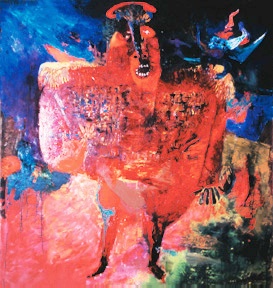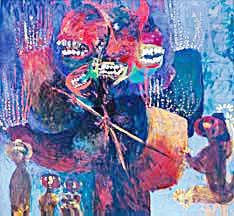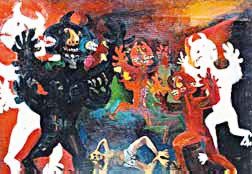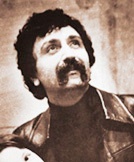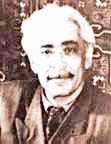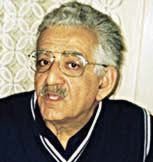|
Spring
1998 (6.1) The Sixties by Vagif Samadoglu Paintings by Rasim Babayev
Although Azerbaijan did not become an independent nation again until 1991, Vagif Samadoglu writes that the seeds of this movement were planted in the Sixties. He believes that you can detect them in the patterns of art, literature and politics. The Sixties was a period that marked a formation of "New Tastes" and aesthetics, reflecting a growing independent spirit in Azerbaijan and other Soviet republics. "The Sixties" - meaning the 1960s is a term accepted throughout the Western world, including the post-Soviet and Eastern European countries, that refers to the renaissance of science, philosophy, literature and art. It was during the Sixties that the ideas of national independence and liberation in Azerbaijan were also unleashed. The "bridles were unharnessed," so to speak, in both art and literature. But how did these ideas start in the Soviet Union? Where did they originate? Actually, ideas were born during the period when Nikita Khrushchev (1894-1971) first became the Soviet Union's Premier and First Secretary of the Communist Party during the period often referred to as the "Khrushchev Thaw."
Khrushchev Thaw Khrushchev was the direct executor of those cruel events in 1933. In his report, he insisted that he had only been following Stalin's orders. But Khrushchev was not telling the whole truth. Khrushchev was driven by his desire to take revenge against Stalin. Memoirs of Stalin mention how he often made fun of Khrushchev, forcing him to perform the Ukrainian dance, "Gopak," in front of others. Khrushchev was Ukrainian, and he was short and fat. The Gopak requires quick movements and a trim, fit body. When Khrushchev danced the Gopak he looked quite ridiculous. It's likely that Khrushchev was deeply resentful of Stalin for these insults and, hence, the urge to insist on de-Stalinization. During Khrushchev's first two years in power, he extended a bit of freedom to the arts and to literature, though he did not eliminate censorship. Translations of Western literature were permitted. Before Khrushchev took office, the journal "Inostrannaya Literature" (Foreign Literature), published only the works of foreign writers who were members of the Communist Party. But after he came to power, the public was allowed to read American writers such as Ernest Hemingway, John Steinbeck, William Faulkner and J. D. Salinger, and German writers such as Heinrich Boell. The fiction of French existentialists Jean-Paul Sartre and Albert Camus became available, but not the philosophical works. He teased the masses with a little taste of freedom, despite the restrictions. The entire world, including the United States, started to hope that a "softer Communism" would soon replace the severe isolation and authoritarianism of the "Iron Curtain." As for me, I didn't believe it would. My friends and I always observed that these gestures lacked sincerity and genuineness. We knew that all Communist leaders always manipulated events to enhance "the cult of personality." As events unfolded, we proved to be right. A New Cult of Personality Poets often got together to read and recite their poems in front of Vladimir Mayakovski's monument in Moscow. [Mayakovski (1893-1930) was a famous Soviet poet.] Of course, it didn't take long before the Soviet power forbade these gatherings, too. And so the "cult of personality" continued throughout the Brezhnev era and into Gorbachev's rule, though it took on a different form. Despite the fact that the "Khrushchev Thaw" only lasted for a short period of time, a great resonance was felt throughout Eastern European countries. In some countries, the movement of democratization grew so much that leaders of those countries couldn't contain the momentum. This movement developed in various directions, demanding freedom of speech, human rights and national liberty. Crimean Tatars were among the first to start a national liberty movement. [The Tatars are a group of people living in Russia who speak a Turkic language.] Similar movements also developed in Georgia and Azerbaijan.
Sparrow Society Members of similar societies in other Republics were arrested by the KGB and severely punished. Let me point out that in Azerbaijan, no one was arrested. At that time, the KGB in Azerbaijan was headed by Heydar Aliyev, now President of Azerbaijan. The Sparrow Society members were called to the KGB offices. Each of them was reprimanded, but no one was arrested. In all honesty, I must say that Aliyev's policy was very far-sighted, much more so than those of the other leaders in the Former Soviet Republics. If the Sparrow Society's members had been severely punished, they would have turned into serious dissidents. Instead, their actions were treated like a child's naughtiness. Naturally, the Sparrow Society collapsed. Many of them were my friends. Today we look back on those days with a feeling of pride, tinged with a sense of humor at our naiveté. I, too, could have become a serious dissident. At one official party, I raised a toast to Alexander Solzhenitsyn, a writer who was "persona non grata" in the Soviet regime. I'm sure that top circles were later informed about my toast. But I didn't suffer for it. In other Republics, I could have been arrested for such a provocative act. Tanks in Prague A few days before the Russian tanks entered Czechoslovakia, a Russian news program showed the Writers' Congress in Czechoslovakia. One writer, Yan Prokhazski, took the floor and uttered the simple phrase: "There is no censorship!" Then he started to cry. The entire audience stood up and raised their national flags. The Russian news program severely criticized these events and used them as an excuse to attack the country. A few days later, Soviet tanks descended on Prague and strangled the liberation movement. The USSR had a habit of destroying resistance with tanks. Remember: Berlin (1951), Hungary (1956), Czechoslovakia (1968), Afghanistan (1979) and, most recently, Azerbaijan (1990). World-Famous Dissidents Solzhenitsyn (born in 1918), winner of the Nobel Prize for Literature in 1970, wrote a series of works criticizing the Stalinist Repression. His novel "The Gulag Archipelago" is considered to be an encyclopedia of persecution. Published during Krushchev's rule, these were memoirs written about his own experiences which he used to criticize the Soviet repression camps. Khrushchev gave the green light to the novel, "One Day in the Life of Ivan Denisovich," thinking it exposed Stalin. What he didn't realize was that the story was, in fact, challenging the entire Soviet system. The novel exploded like a bombshell. Solzhenitsyn published another similar story and was soon forbidden to publish his works inside the USSR. Nevertheless, he managed to get them printed in Europe. In fact, it could be said that it was the Nobel Prize that protected Solzhenitsyn from being sent to prison or another repression camp. In 1974 he was exiled from Russia, and moved to Switzerland, and later to the U.S. In 1994 he returned to Russia. Andrei Dmitriyevich Sakharov (1921-1989) was another world-famous giant of the 1960s. His name is usually associated with the invention of the hydrogen bomb, but he led the dissident movement in Russia, which began in the Sixties. At first, his protests centered around the use of the hydrogen bomb, but then spread to the areas of human rights and freedom of speech. He was the spiritual, non-official leader of the dissident movement in the USSR and was well-respected by the Soviet intelligentsia. Because of his dissent, he was not allowed to leave Moscow and was kept under house arrest. In my opinion, however, Sakharov misjudged the Karabakh situation entirely. He seems to have been very much influenced by his wife, an Armenian, and his position was clearly anti-Azerbaijani. It's very curious to look back and discover that the liberation movements of the former Soviet Republics were all headed by representatives of the Sixties; for example, in Azerbaijan (Elchibey), in Georgia (Gamsakhurdiya), in Armenia (Ter-Petrossian), and in Lithuania (Brazauskas). Today's President of the Czech Republic, Vaclav Havel, was also a dissident writer in the Sixties. He, too, languished in jail many years as a political prisoner. Foreign Translations In brochures with titles like "Eclipse of the Mind," they criticized the works of these writers. They said, "Look what kind of nonsense Freud is saying," or "Look what Camus says. How ridiculous!" Then they would use the next two or three pages to print pages from the original works they had translated into Russian. They repeated this process several times in a single brochure. (It should be noted that at least 90 percent of these translators were Jews.) It was through these publications, passed from hand to hand, that I learned about existentialism. This was a period of time when the philosophy of existentialism was spreading throughout the world. I'm certain this approach served to raise our consciousness. Sixties Poetry Two opposing camps of poets began distinguishing themselves during this period - the traditionalists and those who experimented and wrote free verse without rhyme. Often there was no meter and the number of syllables didn't parallel other lines. The traditional poets said that we, the representatives of free verse, were not even poets, and that such works were anything but poetry. We replied by saying that the traditional poets were not poets but were "ashugs" (wandering minstrels). Rasul Reza was the brightest star of free verse. His poems contributed considerably to the formation of the New Taste and helped to break down barriers in poetry. Let me say that there was a tendency for those of the Sixties to reject everything and everyone that had preceded them. But how can you reject such great poets as Nizami, Fuzuli, Vagif and Samad Vurgun? But during this period, poetry was affected in various ways - in form as well as content. Consider, for example, my father Samad Vurgun's (1906-1956) poetry when he wrote, "Poet, how early you have become old." The idea hinted of pessimism - a forbidden topic. Another of his famous poems, "I'm Not in a Hurry," contradicted the Communistic ideology which insisted that everybody "was hastening forward to Communism with great, long strides." Vurgun wrote these poems in the late 1940s [See "Samad Vurgun, Father & Poet: 90th Jubilee," AI 4.1, Spring 1996]. Another example of the New Taste is a line from a poem [1958] written by Fikrat Goja: "The Caspian is an ordinary sea with saltwater." This straightforward imagery sent out shock waves because, in most poems, everything was praised with metaphors and flowery phrases. The Caspian, as well as other famous seas, lakes and mountains was "great," and everyone was always "happy." It created quite a sensation to reduce this body of water to the mundane and suggest that the Caspian was nothing but ordinary saltwater. Sixties Prose In the literature of the Sixties, the "Theater of the Absurd" flourished. This school insists that everything in life is absurd. Arthur Miller wrote some such works. So did Eugene Ionesco (1909-1994), who became one of the best-known purveyors of absurd literature. In "Rhinoceros" (1959), his most popular play, the protagonist holds on to his humanity in a world where humans are changing into beasts. The Sixties were a time when absurdity and surrealism pushed the frontiers of the imagination. Azerbaijani writers were also subject to this trend, despite the fact that the Soviet regime always insisted on socialist realism. Sixties Music His approach was criticized as "something imported from the bourgeois world." Officially, it was prohibited by the Soviet regime. But Garayev was intrinsically linked to this modernist school of music, and even students from the Moscow Conservatory came to Azerbaijan specifically to study with him. Mugam performers gave new interpretations to their music during the Sixties. For example, Ramish became very famous for being the first musician to perform mugams on the electric guitar. This was revolutionary at the time. The Sixties also gave birth to the mugam jazz of Vagif Mustafazade. This was also the time when the saz, a traditional stringed instrument, was first used in solos. Prior to this, saz melodies were performed by "ashugs" at big parties. For the performance of epics, the ashugs would sing and accompany themselves on saz. Ashig Adalat, a famous musician, started playing solo saz in the Sixties. Vladimir Vysotsky was the most famous poet-singer to criticize the darker aspects of society in his songs. He not only played the guitar, but wrote the lyrics and melodies for his tunes. "Dada Gorgud"
and Gobustan The Gobustan cave dwellings were inhabited at least 5,000 years ago. Located about 30 minutes west of Baku, the cave features drawings of animals, people, dancers and reed boats. In the Sixties, rock drawings in Sakhara and Nepal were made known to the whole world through UNESCO [United Nations Educational, Scientific and Cultural Organization]. Azerbaijan became sensitive that the outside world had no clue about our own pre-historic drawings at Gobustan. I'm very proud that my father, Samad Vurgun, did his best to protect Gobustan while he was a Vice President at the Academy of Science. These boulders were in danger of being used for construction materials. Due to his initiative, Gobustan was designated as a protected area. "Dada Gorgud," a Turkic literary epic, chronicles the heroic deeds of the Oghuz Turks. Though transmitted via oral tradition for centuries, it was finally written down in the 15th century. Its motifs are closely related to Homer's 8th century "Odyssey," and scholars often compare the events and characters of these two epics. [See "Dada Gorgud: Passionate Tales of the Middle Ages" AI 4.3, Autumn 1996]. Stalin forbade the study of "Dada Gorgud;" he didn't want Azeris to become aware of their common heritage with other Turkish peoples. He feared a movement of Turkish reunification and forbade everything with a nationalistic theme. After Stalin's death, when it was no longer prohibited, research on the "Book of Dada Gorgud" started in Azerbaijan in the late 1950s.
The Azerbaijani people couldn't help but be influenced by these revolutionary ideas about independence and freedom. These intellectuals provided some of the milestones by which the Soviet and Eastern European states eventually gained their independence. In retrospect, it's worthwhile to ask ourselves where we might be today without the fusion of East and West in the mugam jazz of pianist Vagif Mustafazade, or the dissonant symphonies of composer Gara Garayev or the penetrating words and thoughts of poet Rasul Reza? Jala Garibova was also deeply
involved in the preparation of this essay. |

